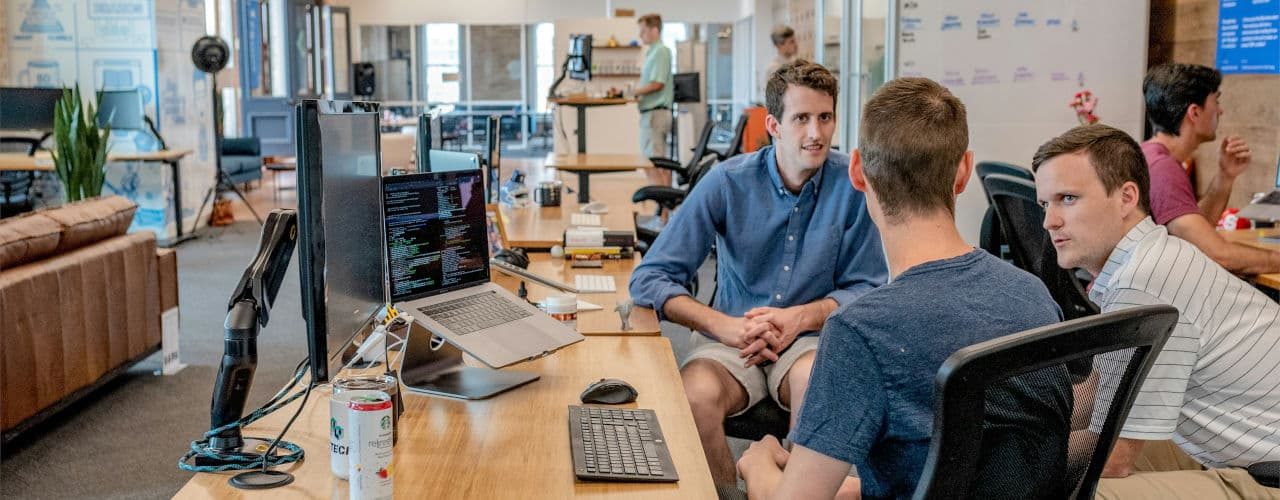
Best Office Layout For Collaboration
The ability to get your team in one place and collaboration is one of the most valuable qualities of good office design. Exactly how your team works together is another question. For some teams, collaborative working means having everyone around one table to finish a task. For others, a mixture of personal and communal space will help your team deliver their best work.
Office layout design ideas
Modern coworking office spaces should be able to accommodate the varied needs of your team. What your business needs in order to function at its best will change over time depending on your staffing levels, your team objectives and the interpersonal dynamics of the employees.
The best office layout for collaboration therefore depends on the needs of your team, and of course, the flexibility of your office space. Here are some ideas to get you started.
Open plan work area
An open plan office removes the walls and barriers between individuals and teams, which can hamper face-to-face communication. When combined with hot desks, staff have the flexibility to move around the office and sit where they choose. This way, they can form small temporary groups for as long as necessary to solve the problem at hand before resuming their individual work.
Pros: Simple, flexible.
Cons: Lack of privacy, noise.
Central shared work space
A central shared space provides a large desk which can be used by many people at once, while the rest of the office is filled with regular desks (which can be hot desks or allocated workspaces). The central desk provides a designated collaborative work area which can be used as and when needed.
Pros: Clearly designated space for collaboration.
Cons: Limits options with multiple smaller teams.
Separate desks with breakout spaces
Individual desks are provided with smaller breakout areas scattered around the office, such as groups of comfy chairs around coffee tables. Compared to the central shared workspace, this approach decentralises the collaborative space in favour of smaller, more comfortable areas. This provides additional flexibility and prevents an area being dominated by one team. The downside is that each breakout space may be is likely to be smaller than a central collaborative zone.
Pros: Ideal for relaxed or discussion-focussed collaboration. Clear separation of spaces based on ‘work’, and ‘comfort’.
Cons: Relaxed collaborative areas may not be suitable for workers who would benefit from a keyboard, mouse, and desk.
Desks with collaborative zones
This layout is similar to the breakout spaces, except that the spaces here retain their office focus, and are clearly ‘working’ areas with desks and office chairs, rather than the more comfortable and relaxed spaces above. There is a good reason to consider both. While some collaborative work is conceptual, centred on discussion and problem solving, other collaborative tasks need workers to be at their computers. Bringing your team together around a desk will be more suited for organisations that need to come together to deliver results, rather than brainstorm.
Pros: More desks means simpler furnishing decisions.
Cons: Zones might be too small to accommodate larger groups. Lack of variety in the workspace may limit creative thinking.
Modular workspaces
In this office design layout, the space is kept flexible. Desks can be reconfigured as needed to create new workspaces and zones. This type of office layout is not always the most practical on a day-to-day basis, as moving the furniture could also involve dealing with cable runs and desk items like monitors. The upside is that it can allow for a fully modular office which can be reconfigured on the fly to accommodate individual desks, islands, or fully open spaces to accommodate stand-up meetings, for example.
Pros: Most flexible option.
Cons: Reconfiguring the office when necessary will break the team workflow. May need specialised furniture to accommodate ease of movement.
No matter which office layout design you settle on, make sure you take into account the amount of office space you need per person. Find more information on this, plus other subjects in our world of work series of articles. Electric Works N7 is the ideal place to set up your flexible or hybrid office space.
